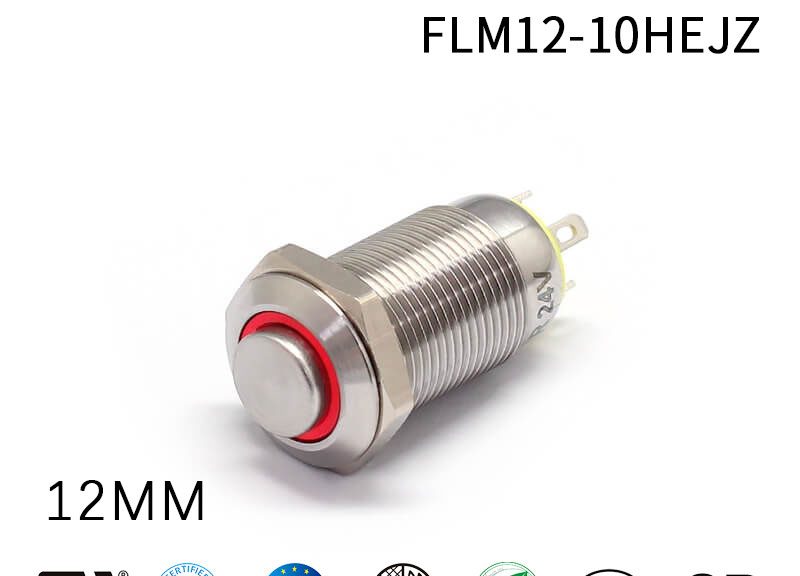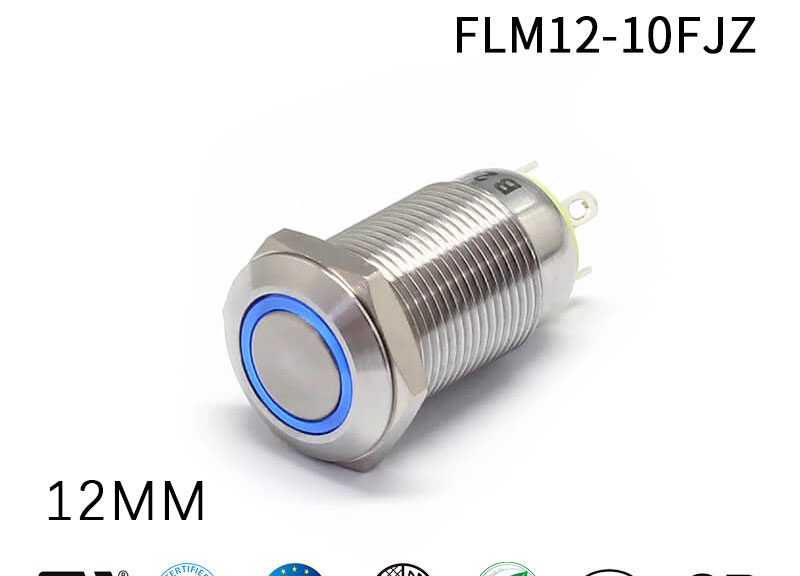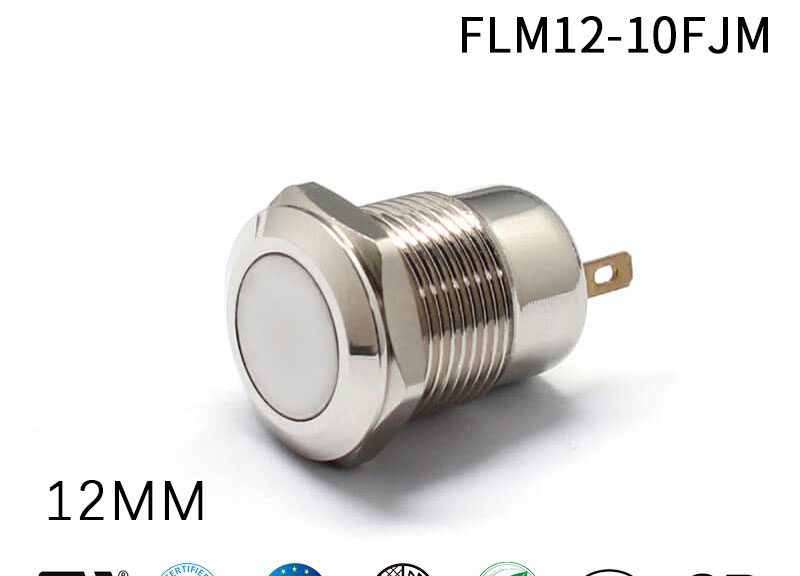Product Drawings:

The small button switch is a type of button in the button switch.It is a button switch that looks relatively small.
Generally, the small button switch without light has two pins. Like the conventional button switch, they can control the on and off of the circuit by pressing.Usually, (NO) stands for normally open, (NC) stands for normally closed.
There is a difference between a small push button switch and a micro button, and the size of the micro button is even smaller.
Product Parameters:
| Production Series | FLM12-10HEJZ | Light Guide Button | PC plastic |
| Button Shape | round | Actuator | 304 Stainless steel |
| Button LED Color | red,blue,green,yellow,white | Housing Sleeve | H59 nickel plated brass/304Stainless steel |
| Mechanical Life | The 500 thousand time | Button Pin | H62 Copper alloy |
| Electrical Life | The 100 thousand time | Rubber Ring | SIL silica gel |
| Protection Level | IP65 IK08 | Nut | H59 nickel plated brass |
| Rated Voltage | 36V(DC) 250(AC) | Housing | PA66+GF20% nylon |
| Rated Current | 1A(DC)0.5A(AC) | Light Source | LED |
| Rated Power | 36W(DC)125W(AC) | Resistor | Metal film |
| Operating Temperature | -25℃~+85℃ | Contact | AgCdO12 |
Pushbutton Switch Wiring Method:
The product has 2 wiring ways, which is with 4 pins and 1 NO . You can save this image and test it.
The wiring way is very simple, first of all we need to know that the product has 4 pins, 2 are switch pins, the other 2 are light pins, the light pins are regardless of positive pole or negative pole, the wiring way is as follows.

Wiring way 1
The switch near the lamp line is connected to a line, then connect to the device again.
The other line of the device is connected to the light line and power line, the power’s other line is connected to the switch’s other pin.
When press down the push button, the device starts to work and the light of the product will light up, when release the hand , the light and device are both disconnected.
Wiring way 2
The switch pin and light pin are connected to one pole of the power, the other pole of the power is connected to the other LED pin and device.
The light of the product will be on always. When you press down the switch, the device starts to work.
FILN Pushbutton Switch Customization
Advantages of Customization:
- Personalization: Symbols tailored to individual preferences.
- Customizable Voltage and Color: Tailored voltage and color options.
- Diverse Wiring Options: Multiple wiring methods to suit diverse needs.
- More Affordable Pricing: Cost-effective pricing choices.
Applications:
- Industrial Applications
- Home Automation
- Automotive Integration
- Medical Devices
- Consumer Electronics
- Public Infrastructure
- Commercial Use
- Security Systems
- Hospitality Industry
- Transportation Use
Related products:
Small Push Button Switch: Comprehensive Guide
Small push button switches are an integral part of various electronic devices, offering functionality and customization in numerous applications. From the intricacies of their design, materials, wiring techniques, to the specialized types like momentary push button switch or normally closed push button switch, this article provides a comprehensive guide. Whether you’re exploring innovative solutions like tactile push button switches or seeking eco-friendly manufacturing and disposal practices, this guide covers all aspects. Delve into this detailed exploration of small push button switches to understand their versatile usage, how to purchase, and much more, ensuring you make informed decisions in your personal or professional endeavors.
What Are Small Push Button Switches and How Are They Used?
Small push button switches are common devices used to control circuits. These buttons come in various types, such as mini push button switch 2 pin, nc push button switch, and momentary push button switch. Below, you will find detailed information on their applications, functionality, and specifications.
Overview:Small push button switches are designed to enable or interrupt the flow of electricity within a circuit. By pressing the button, the user can activate or deactivate a device. A good example is the mini push button switch on/off, used in a wide variety of applications.
- Momentary Push Button Switch: It returns to its normal position after being released.
- Normally Closed Push Button Switch (NC): Stays closed until the button is pressed.
- Miniature Push Button Switches: Available in various sizes for compact applications.
Applications:These switches are found in industrial machines, consumer electronics, and automotive applications. An excellent example is the mini push button switch 2 pin used in mobile devices and small appliances.
What Are the Specifications and Ratings of Small Push Button Switches?
Understanding the specifications and ratings of small push button switches is essential to choosing the right switch for your needs.
Voltage and Current Ratings:Most small push button switches are designed to handle specific voltage and current ranges. Some can handle up to 12 volts, such as 12mm push button 12 volt switches.
Durability:Small push button switches’ lifespan depends on the number of cycles it can withstand. Durable switches like the IP65 momentary mini push button switch can last for millions of cycles.
Mounting Options:Different mounting options include panel mount, PCB mount, or surface mount. Specific types like 16mm 12v push button switch panel are designed for panel mounting.
How to Choose the Right Small Push Button Switch for Your Application?
Choosing the right small push button switch requires considering several factors, including the type, specifications, materials, and the application’s specific needs.
Define the Requirements:Identify your application’s specific needs, such as voltage, current rating, or whether you need a normally closed push button switch.
Consider the Environment:Environmental factors like temperature, moisture, and exposure to chemicals can affect the choice. Consider switches like the 16mm pushbutton harness designed for specific environments.
Consult a Specialist:When in doubt, consulting a specialist or using online resources like the push button switch category on various platforms can guide you to the perfect solution.
How to Maintain and Troubleshoot Small Push Button Switches?
Maintaining and troubleshooting small push button switches prolong their lifespan and keep them in optimal condition.
Regular Inspection:Regular inspection for signs of wear or damage can prevent failures. Understanding the momentary meaning of switches will aid in this process.
Cleaning:Proper cleaning using appropriate methods ensures that the switch continues to function efficiently.
Professional Services:For complex issues, it might be best to seek professional services or visit the indicator light website for further guidance.
What Are the Trends and Innovations in Small Push Button Switch Technology?
Small push button switch technology continues to evolve, with innovations and trends shaping the industry.
Miniaturization:The trend towards miniaturization, such as miniature momentary push button switches, accommodates the demand for compact devices.
Smart Technology:Integration with smart technology allows for more convenient control and monitoring.
Sustainability:The focus on environmentally friendly materials and energy-efficient designs represents a significant trend in the industry.
What Are the Legal and Regulatory Considerations for Small Push Button Switches?
Legal and regulatory considerations must be observed when dealing with small push button switches, ensuring compliance and safety.
Certification and Standards:Products must meet specific standards such as UL, CE, or RoHS. Look for certified products like 12-volt momentary push button switches to ensure quality and compliance.
Import and Export Regulations: Understand the import and export regulations specific to your country to avoid legal complications.
Environmental Regulations:Adhering to environmental regulations is essential, especially in the manufacturing and disposal of these switches.
How Can Small Push Button Switches Be Customized?
Customization of small push button switches is often required to meet specific application needs or aesthetic preferences.
Custom Design Options
- Color Customization: Choose specific colors to match brand identity or user preferences.
- Size Modification: Custom sizes like miniature push button switches can fit specialized applications.
- Logo and Branding: Incorporate logos or branding for a unique appearance.
- Functional Customization: Adjusting functionality such as tactile push button switches or momentary normally closed push button switches.
Process of Customization
- Define Requirements: Detail the specific customizations required.
- Consult with Manufacturers: Work with specialized manufacturers or use platforms like Indicator Light.
- Review Samples: Obtain and evaluate samples for quality and specifications.
- Finalize Order: Confirm the order, ensuring it meets all customization requirements.
Considerations for Customization
Consider factors like cost, lead time, and minimum order quantity when customizing small push button switches. Always consult professionals to ensure customization meets industry standards.
Where Can You Buy Small Push Button Switches?
Purchasing small push button switches requires careful consideration of various factors, such as quality, price, and vendor reputation.
Online Platforms:Online platforms offer a wide variety of options. You can find everything from a mini push button switch 2 pin to normally closed push button switch on sites like Indicator Light’s category page.
Physical Stores:Physical stores provide the opportunity to inspect the products and consult sales professionals for advice.
Direct from Manufacturers:Buying directly from manufacturers may offer competitive pricing and customization options. Explore products like momentary push button ignition switch directly from manufacturers.
Considerations When Purchasing:
- Quality Certification: Look for certifications like UL, CE, or RoHS.
- Return Policy: Understand the vendor’s return or warranty policies.
- Price Comparison: Compare prices across vendors to find the best deal.
- Consult Reviews: Check customer reviews to gauge product quality and vendor reliability.
What Are the Different International Standards for Small Push Button Switches?
International standards for small push button switches ensure quality, safety, and compatibility across global markets.
Common International Standards:
- UL (Underwriters Laboratories): Safety certification for the United States.
- CE (Conformité Européenne): Compliance with European Union directives.
- RoHS (Restriction of Hazardous Substances): Ensures products are free from specific hazardous materials.
Importance of International Standards:
- Quality Assurance: Standards guarantee product quality and reliability.
- Global Market Access: Compliance facilitates international trade and acceptance.
- Legal Compliance: Adherence to standards ensures alignment with local laws and regulations.
Finding Standard Compliant Products:
Work with reputable vendors or platforms like Indicator Light to ensure products meet the necessary international standards.
Conclusion
The comprehensive guide to small push button switches covers everything from their functions, specifications, wiring, materials, purchasing options, customization, international standards, environmental considerations, and innovations. With various types such as momentary, normally closed, and tactile push button switches, these versatile devices find applications across numerous industries.
Understanding their applications, and specifications, and adhering to legal and regulatory requirements will guide you to make an informed choice, whether you need a simple mini push button switch on/off or a customized solution.
By keeping abreast of the latest trends and utilizing resources like Indicator Light, you can stay ahead in the rapidly evolving world of small push button switches.
Price Range of Small Push Button Switches in the USA
When it comes to purchasing small push button switches in the USA, there are several suppliers to consider. Here’s a detailed breakdown of the approximate price range from various suppliers:
Made-in-China:The price for each small push button switch can range from $0.01 to $100, depending on the specific parameters and features.
Home Depot:The average price for push button light switches at Home Depot ranges from $10 to $150. They carry brands such as Lutron.
Mouser Electronics:Mouser Electronics offers a variety of push button switches, including small options. Prices can vary depending on the specific model and features of the switch[^3^].
All Electronics:All Electronics offers a variety of push button switches, including small options. Prices range from around $0.70 to $5 or more per switch, depending on the specific switch model and features[^4^].
Please note that these prices are approximate and may vary depending on the supplier, retailer, and location. It is always recommended to check with the specific supplier or retailer for the most accurate and up-to-date pricing information on small push button switches.
Price Range Comparison:To give you a visual representation of the price range, here’s a pie chart showcasing the average prices from each supplier
Supplier Comparison:For a more detailed comparison, here’s a table summarizing the price range of small push button switches from each supplier:
| Supplier | Price Range |
|---|---|
| Made-in-China | $0.01 – $100 |
| Home Depot | $10 – $150 |
| Mouser Electronics | Varies |
| All Electronics | $0.70 – $5 |
As you can see, the price range for small push button switches can vary significantly depending on the supplier and specific features required. It’s important to consider your budget and the desired functionality when making a purchasing decision.
In conclusion, the price of small push button switches in the USA can range from as low as $0.01 to as high as $150, depending on the supplier and features. It’s always recommended to research and compare prices from different suppliers to ensure you get the best deal for your specific needs.
Remember to check with the supplier or retailer for the most accurate and up-to-date pricing information, as prices may vary over time.
About Button Switch Manufacturer-FILN
FILN has 11 years of button production experience, and has a professional R&D technical team, who is good at customizing various button switches for you according to customer requirements.
This small push button switch produced by Filn has passed UL, CE, ROSH, ISO90001 and other certifications, and has a professional push button switch testing laboratory, which can guarantee the quality of the product.
If you have any questions about the small push button switch, please contact us immediately, we will give you a satisfactory answer within 24 hours.
Filn also produces indicator lights, rocker switches, touch screens, temperature detection switches, etc. If you have any needs for the products, please contact us.






















